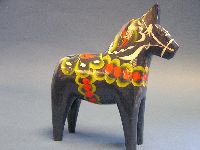
6.75 inch Blue Mora Dala Horse
Code: 6216
Quantity in Basket:
NonePrice:
$68.95Mora Dala Horse.
The Story of the Dala Horse A horse represented a creature of great value, a tower of strength in helping the family. It was a faithful friend who pulled loads in the forest during the winter, worked in the field and meadow when Spring and Summer arrived. The horse carried equipment up to the delightful summer pastures and adjoining houses and also provided the daily transport between villages and the countryside, as well as transport for different events throughout the year. Be it trips to the mill, to market, to church, the horse really "pulled its weight", a veritable beast of burden.
There was so much pleasure with a horse as children really enjoyed their company; they could ride bareback and many at one time were able to sit on a broad strong back.
It was quite natural that people carved horses. You can trace the origin of this craft back to the lumberjacks log cabins as early as the 18th century. There they would sit around the open fires during the winter, resting after the days tree-felling and transporting logs. Having prepared and eaten their meal, checked over their tools, they often relaxed by carving figures from odd pieces of wood. The popular choice was a horse and these were taken home to the children in the villages. They became highly treasured toys for play both in and out doors.
During the Nineteenth Century it became custom to paint the wooden horses with richly colored flower patterns like the Dala Paintings that decorated furniture and interior walls. Those who traveled about the country to sell products of the home cottage industry; baskets, grinding stones, wooden casks, also took along Dala Horses to add to their selection of goods. The latter were often used as payment for board and lodging.
Wooden horses originally came from the Mora Villages of Vattnäs, Risa, Bergkarlås, and Nusnäs. These horses are today known as Mora horses in the family of Dala horses. Other dala horses which are made around the Lake Siljan area are the Rättvik, Siljan, Leksand, Sjurberg horses. The most well-known carver from the old days was Tysk Anders Gunnarsson, known as "Gambel Damben". In 1928 the brothers Nils and Jannes Olsson took up the old handicraft. Nils was 15 and Jannes was 13 years old. Since then the genuine Mora Dala Horses have been made again in the Nusnäs workshops, and in surrounding villages many people are fully occupied with carving horses to be collected and delivered to the workshop.
The wood for the horses from Dalecarlia comes form the forests around Lake Siljan and Lake Orsa (Pine and Spruce) Here the trees are slow growing and produce an excellent wood for carving. The only work done by machine is the sawing out of the shape. The rest is pure craftsmanship. After priming, the horses are dipped in red, blue or black paint before being decorated in their traditional patterns. Often it is artistically inclined girls who skillfully conjure forth the "Krusningen" as the decoration is known in Nusnäs. No two horses are alike.
Also made at the hemslöjd are cockerels and traditional grandfather clocks (Mora Klocka), as well as clogs. This authentic handicraft continues as before in the province of Dalarna. Anderson Butik carries a wide assortment of traditional Dala Horses manufactured by the Nils Olsson Dala Horse Hemslöjd located in Nusnäs, Sweden. Available in a variety of sizes in either Red or Blue base colors. Additional sizes available upon request. Price varies by size.
#f7ffff
Related Item(s)
Name
Price
$39.95
$39.95
$48.95
$48.95
$58.95
$58.95